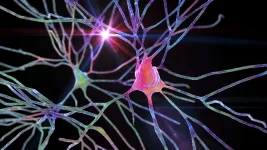(Press-News.org) People often assume that the products they use every day are safe. Now a new study by Silent Spring Institute and University of California, Berkeley exposes how much people come into contact with toxic ingredients in products, used at home and at work, that could harm their health. Findings from the analysis could help state and federal agencies strengthen chemical regulations and guide manufacturers in making safer products.
Many common products like shampoos, body lotions, cleaners, mothballs, and paint removers contain toxic volatile organic compounds or VOCs—chemicals that escape as gases, accumulate in indoor air, and cause a variety of health problems including cancer. Because companies, for the most part, are not required to disclose what it’s in their products or how much, it’s difficult to know what people might be exposed to and the potential health effects.
“This study is the first to reveal the extent to which toxic VOCs are used in everyday products of all types that could lead to serious health problems,” says lead author Kristin Knox, a scientist at Silent Spring Institute. “Making this information public could incentivize manufacturers to reformulate their products and use safer ingredients.”
For the analysis, Knox and her colleagues turned to an unlikely source of data: The California Air Resources Board (CARB). For more than 30 years, CARB has been tracking VOCs in consumer products in an effort to reduce smog. In the presence of sunlight, VOCs react with other air pollutants to form ozone, the main ingredient in smog.
Under its Consumer Product Regulatory program, CARB periodically surveys companies that sell products in California, collecting information on a wide range of items—everything from hair spray to windshield wiper fluid. The data include information on the concentration of VOCs used in various types of products and how much of each product type is sold in the state. CARB does not share data on specific products.
Reporting in the journal Environmental Science & Technology, the researchers analyzed the most recent CARB data, focusing on 33 VOCs listed under California’s right-to-know law, Prop 65, because they cause cancer, birth defects, or other reproductive harm. The law requires companies that sell products in California to warn users if their products could expose them to significant amounts of these harmful chemicals.
The team’s analysis found more than 100 types of products contain Prop 65 VOCs. Of those, the researchers identified 30, including a dozen different types of personal care products, that deserve special scrutiny because they frequently contain harmful chemicals and may pose the greatest health risk. (Since CARB only reports on VOCs, many other toxic chemicals listed under Prop 65, such as lead, were not included in the analysis.)
Products used on the job are especially concerning, the authors note, because workers often use many different types of products, each of which likely contains at least one hazardous chemical. For instance, nail and hair salon workers use nail polishes and polish removers, artificial nail adhesives, hair straighteners, and other cosmetics. According to the analysis, these types of products combined contain as many as 9 different Prop 65 VOCs. Janitors might use a combination of general cleaners, degreasers, detergents, and other maintenance products, which could expose them to more than 20 Prop 65 VOCs.
“The same thing goes for auto and construction workers. All these exposures add up and might cause serious harm,” says co-author Meg Schwarzman, a physician and environmental health scientist at the UC Berkeley School of Public Health who led the study. “At the most basic level, workers deserve to know what they’re exposed to. But, ultimately, they deserve safer products and this study should compel manufacturers to make significant changes to protect workers’ health.”
Of the 33 VOCs listed under Prop 65, the researchers identified the top 11 chemicals that manufacturers should eliminate from products because of the chemicals’ high toxicity and widespread use. Other findings include:
Among products used on the body, formaldehyde was the most common Prop 65 VOC, and was found in nail polish, shampoo, makeup, and other types personal care items.
For products used in the home, general purpose cleaners, art supplies, and laundry detergents contained the most Prop 65 VOCs.
Adhesives contained more than a dozen different Prop 65 VOCs, highlighting that workers can be exposed to many toxic chemicals from using just one type of product.
Finally, the team used the CARB data to calculate the total amount of Prop 65 VOCs emitted from consumer products indoors, and found more than 5,000 tons of volatile Prop 65 chemicals were released from products in the state of California in 2020. Nearly 300 tons of that came from mothballs (1,4-dichlorobenzene) alone.
“Although Prop 65 has reduced the public’s exposure to toxic chemicals both through litigation and by incentivizing companies to reformulate their products, people continue to be exposed to many unsafe chemicals,” says co-author Claudia Polsky, Director of the Environmental Law Clinic at UC Berkeley School of Law. “This study shows how much work remains for product manufacturers and regulators nationwide, because the products in CARB’s database are sold throughout the U.S.”
The new study offers solutions by highlighting the types of products manufacturers should reformulate to replace toxic VOCs with safer ingredients. The authors also suggest, based on their findings, that the U.S. Environmental Protection Agency consider regulating five additional chemicals under the Toxic Substances Control Act (TSCA). These chemicals include ethylene oxide, styrene, 1,3-dichloropropene, diethanolamine, and cumene.
For more tips on how to limit everyday exposures to harmful VOCs and other chemicals of concern, download Silent Spring’s Detox Me app.
Funding for this project was provided by the California Breast Cancer Research Program (Grant #23QB-1881), payments that private litigants directed to Silent Spring Institute in lieu of civil penalties in Prop 65 enforcement cases to further the cause of toxics reduction, and charitable donations to Silent Spring Institute.
Reference: Knox, K.E., R.E. Dodson, R.A. Rudel, C. Polsky, and M.R. Schwarzman. 2023. Identifying toxic consumer products: Novel data set reveals air emissions of potent carcinogens, reproductive toxicants, and developmental toxicants. Environmental Science & Technology. https://doi.org/10.1021/acs.est.2c07247
About Silent Spring Institute: Silent Spring Institute, located in Newton, Mass., is the leading scientific research organization dedicated to uncovering the link between chemicals in our everyday environments and women's health, with a focus on breast cancer prevention. Founded in 1994, the institute is developing innovative tools to accelerate the transition to safer chemicals, while translating its science into policies that protect health. Visit us at www.silentspring.org and follow us on Twitter @SilentSpringIns.
END
More than 5,000 tons of toxic chemicals released from consumer products every year inside homes and workplaces
Study shows people exposed to multiple chemicals that can cause cancer, birth defects, or reproductive harm
2023-05-02
ELSE PRESS RELEASES FROM THIS DATE:
Researchers discover that the ice cap is teeming with microorganisms
2023-05-02
There are no plants, and only very few animals: people rarely come here. The large glaciers in Greenland have long been perceived as ice deserts. Gigantic ice sheets where conditions for life are extremely harsh.
But now, it seems, we have been wrong. There is much more life on the glaciers than we thought.
Headed by Professor Alexandre Anesio, a group of researchers from the Department of Environmental Science at Aarhus University have discovered that the glaciers are teeming with life. Microbes that have adapted to ...
Behavior patterns of people who achieve clinically significant weight loss
2023-05-02
COLUMBUS, Ohio – A new study analyzing data on over 20,000 U.S. adults links a healthier diet and increased exercise to weight loss that reduces heart disease risk – while associating skipping meals and taking prescription diet pills with minimal weight loss, weight maintenance or weight gain.
For many in the study sample, however, losing a “clinically significant” 5% of their body weight did not eliminate their risk factors for cardiovascular disease, results showed. In fact, the average ...
Accelerating coral reef science: building consensus around the assessment and interpretation of Symbiodiniaceae diversity
2023-05-02
New research published in PeerJ Life and Environment by Dr. Sarah Davis and sixty-one scientists from 12 countries presents a perspective to build consensus around the assessment and interpretation of Symbiodiniaceae diversity. Symbiodiniaceae is a family of marine dinoflagellates (plankton) notable for their symbiotic associations with reef-building corals, sea anemones, jellyfish, marine sponges and other marine invertebrates. Understanding Symbiodiniaceae is important to those working to protect and regenerate coral reefs that are under threat around the world.
"The authors hope this paper will provide a springboard to launch ...
The International World Wide Web Conference selects Seoul Test of Time Award
2023-05-02
The International World Wide Web Conference Committee (IW3C2) announced today that the 2023 Seoul Test of Time Award will be presented to the authors of the paper “A Contextual-Bandit Approach to Personalized News Article Recommendation;” Wei Chu, (Ant Group), Lihong Li, (Amazon), John Langford, (Microsoft) and Robert Schapire (Microsoft).
The award will be presented during the opening ceremony of the 32nd international conference in The ACM Web Conference series (formerly known as The International World Wide Web Conference) hosted by the team in Austin. See https://www2023.thewebconf.org ...
60 years later, high school quality may have a long-term impact on cognition
2023-05-02
NEW YORK, NY (May 2, 2023)--A study of more than 2,200 adults who attended U.S. high schools in the early 1960s found that those who attended higher quality schools had better cognitive function 60 years later.
Previous studies have found that the number of years spent in school correlates with cognition later in life, but few studies have examined the impact of educational quality.
“Our study establishes a link between high-quality education and better late-life cognition and suggests that increased investment ...
Too much water can make whiskies taste the same
2023-05-02
RICHLAND, Wash. – While adding a little water is popularly thought to “open up” the flavor of whisky, a Washington State University-led study indicates there’s a point at which it becomes too much: about 20%.
Researchers chemically analyzed how volatile compounds in a set of 25 whiskies responded to the addition of water, including bourbons, ryes, Irish whiskeys and both single malt and blended Scotches. They also had a trained sensory panel assess six of those whiskies, three Scotches and ...
Machine learning model sheds light on how brains recognize communication sounds
2023-05-02
PITTSBURGH, May 2, 2023 — In a paper published today in Communications Biology, auditory neuroscientists at the University of Pittsburgh describe a machine learning model that helps explain how the brain recognizes the meaning of communication sounds, such as animal calls or spoken words.
The algorithm described in the study models how social animals, including marmoset monkeys and guinea pigs, use sound-processing networks in their brain to distinguish between sound categories – such as calls for mating, food or danger — and act on them.
The study is an important step toward understanding the intricacies and complexities ...
Cellular “cruise control” system safeguards RNA levels in Rett syndrome nerve cells
2023-05-02
Every cell in our body is able to turn genes (DNA) on or off, producing RNA, but when genes are ‘turned on’ to the wrong level it can result in a variety of health conditions.
Rett syndrome is a rare neurodevelopmental condition that causes a loss of motor and language skills over time in girls. The condition is caused by a genetic variation in the MECP2 gene located on the X chromosome, resulting in affected nerve cells in the brain expressing the wrong levels of more than one thousand genes. The end result is that Rett syndrome nerve cells are smaller, less interconnected and less electrically active than healthy controls.
In ...
Study finds gender pay differences begin early, with the job search
2023-05-02
A new paper in the Quarterly Journal of Economics, published by Oxford University Press, indicates that an important part of the pay gap between men and women has to do with how they conduct job searches, with women more likely to accept job offers early while men tend to hold out for higher pay.
Women in the United States earn 84% of what men earn, as of 2020. This disparity is well documented, and economists and the general public have known about the earnings difference for decades. The reasons for this phenomenon are a matter of considerable debate.
Initial conditions in the labor market are long-lasting. Young workers who begin ...
Single-molecule valve: a breakthrough in nanoscale control
2023-05-02
Scientists dream of using tiny molecules as building blocks to construct things, similar to how we build things with mechanical parts. However, molecules are incredibly small - around one hundred millionth the size of a softball - and they move randomly in liquids, making it very difficult to manipulate them in a single form. To overcome this challenge, “nanofluidic devices” that can transport molecules in extremely narrow channels, similar in size to one millionth of a straw, are attracting attention ...
LAST 30 PRESS RELEASES:
Strategic river sensors could have forewarned of Texas Camp flood disaster
Drone sampling of whale breath reveals first evidence of potentially deadly virus in Arctic
Roman soldiers defending Hadrian’s Wall infected by parasites, study finds
Pinochet’s prisoners were tormented with music but still found solace in it, a new book reveals
Fertility remains high in rural Tanzania despite access to family planning
AI-assisted device can improve autism care access
Kinetic careers
Uncovering how parasitic plants avoid attacking themselves to improve crop resistance
Nanoparticle vaccine strategy could protect against Ebola and other deadly filoviruses
Study finds brain care score can predict risk of stroke across racial groups
Key lung immune cells can intensify allergic reactions
Do hormones explain why women experience more gut pain?
New materials conduct ions in solids as easily as in liquids
Breakthrough of the Year: Renewable energy begins to eclipse fossil fuel-based sources
LLM use is reshaping scientific enterprise by increasing output, reducing quality and more
Introducing LightGen, a chip for ultra-fast, ultra-efficient generative AI
Astronomers see fireworks from violent collisions around nearby star
ACC/AHA issue new guideline on managing congenital heart disease in adults
Cosmic crash caught on camera
Is talented youth nurtured the wrong way? New study shows: top performers develop differently than assumed
Ants: An untapped resource in the development of antibiotics?
Archaeologists use AI to create prehistoric video game
Mitochondria migrate toward the cell membrane in response to high glucose levels
Tiny viral switch offers hope against drug-resistant bacteria
Most parents aware of early peanut introduction guidelines, but confused about details
HPV vaccine can protect against severe lesions of the vulva and vagina
Virtual care provision and emergency department use among children and youth
Quadrivalent HPV vaccine and high-grade vulvovaginal lesions
Insights into dry eyes gained from stem cell-derived tear glands
Researchers identify 166 human pluripotent stem cell lines available for use in clinical applications
[Press-News.org] More than 5,000 tons of toxic chemicals released from consumer products every year inside homes and workplacesStudy shows people exposed to multiple chemicals that can cause cancer, birth defects, or reproductive harm




